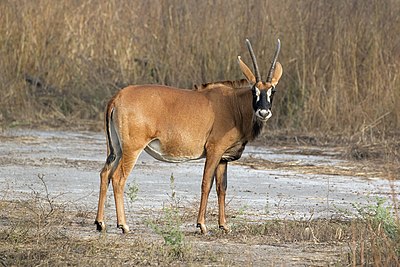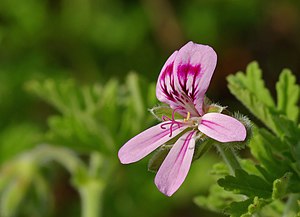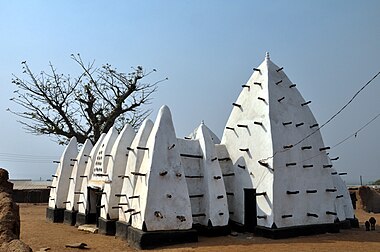Portal:Africa/Featured picture
The Selected picture box on the portal chooses one of the following at random when displaying the page. Follow the instructions below for adding or nominating a new picture to the list.
Picture candidates
[edit]Feel free to add related featured pictures to the list. Nominate other pictures on the portal talk page.
- Pictures must be
- Free to use and hosted on Commons
- Of good quality (not blurred, grainy or discoloured)
- Interesting
- Relevant to an article or topic
To find appropriate pictures, use search box below:
Instructions
[edit]- For pictures, which appeared as picture of the day on the Main Page, just add the date in
YYYY-MM-DDformat to the list (please keep the list sorted). - For other pictures, use following parameters:
|iN= |titleN= |creditN= |captionN=
where N is the next unused number.
Selected pictures list
[edit]Other denominations:
Portal:Africa/Featured picture/1
Portal:Africa/Featured picture/2
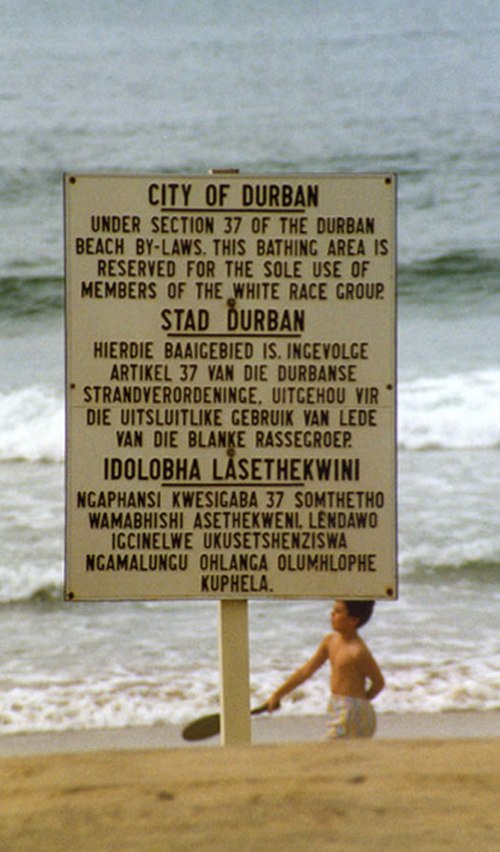
Portal:Africa/Featured picture/3
Portal:Africa/Featured picture/4
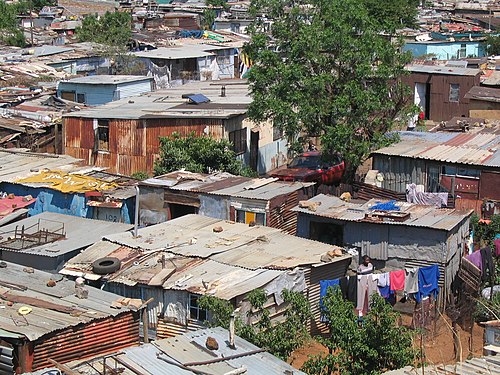
Portal:Africa/Featured picture/5

The giraffe (Giraffa camelopardalis) is an African even-toed ungulate mammal, the tallest of all land-living animal species. Males can be 4.8 to 5.5 metres (16 to 18 ft) tall and weigh up to 1,360 kilograms (3,000 lb). Females are generally slightly shorter and weigh less than the males do. The giraffe is related to deer and cattle, but is placed in a separate family, the Giraffidae, consisting only of the giraffe and its closest relative, the okapi. Its range extends from Chad to South Africa.
Portal:Africa/Featured picture/6

The hippopotamus (Hippopotamus amphibius), from the Greek ‘ιπποπόταμος (hippopotamos, hippos meaning "horse" and potamos meaning "river"), is a large, mostly plant-eating African mammal, one of only two extant and three or four extinct species in the family Hippopotamidae.
Portal:Africa/Featured picture/7
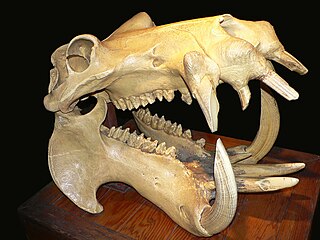
The hippopotamus (Hippopotamus amphibius), from the Greek ‘ιπποπόταμος (hippopotamos, hippos meaning "horse" and potamos meaning "river"), is a large, mostly plant-eating African mammal, one of only two extant and three or four extinct species in the family Hippopotamidae.
Portal:Africa/Featured picture/8

The lion (Panthera leo) is a mammal of the family Felidae and one of four "big cats" in the genus Panthera. The lion is the second largest feline species, after the tiger. The male lion, easily recognized by his mane, weighs between 150–250 kg (330–500 lb). Females range 120–150 kg (260–330 lb). In the wild, lions live for around 10–14 years, while in captivity they can live over 20 years. Though they were once found throughout much of Africa, Asia and Europe, lions presently exist in the wild only in Africa and India.
Portal:Africa/Featured picture/9

The lion (Panthera leo) is a mammal of the family Felidae and one of four "big cats" in the genus Panthera. The lion is the second largest feline species, after the tiger. The male lion, easily recognized by his mane, weighs between 150 and 250 kg (330–500 lb). Females range 120–150 kg (260–330 lb). In the wild, lions live for around 10–14 years, while in captivity they can live over 20 years. Though they were once found throughout much of Africa, Asia and Europe, lions presently exist in the wild only in Africa and India. They enjoy hot climates, and hunt in groups.
Portal:Africa/Featured picture/10

The lion (Panthera leo) is a mammal of the family Felidae and one of four "big cats" in the genus Panthera. The lion is the second largest feline species, after the tiger. The male lion, easily recognized by his mane, weighs between 150 and 250 kg (330–500 lb). Females range 120–150 kg (260–330 lb). In the wild, lions live for around 10–14 years, while in captivity they can live over 20 years. Though they were once found throughout much of Africa, Asia and Europe, lions presently exist in the wild only in Africa and India. They enjoy hot climates, and hunt in groups.
Portal:Africa/Featured picture/11

The Sahara (Arabic: الصحراء الكبرى, aṣ-ṣaḥrā´, "The Great Desert") is the world's largest hot desert at over 9,000,000 square kilometres (3,500,000 sq mi). The Sahara defines the borders of North Africa and has an intermittent history that may go back as much as 2.5 million years.
Portal:Africa/Featured picture/12

The Senufo languages comprise approximately 15 languages spoken by the Senufo in West Africa. They are generally considered a branch of the Gur sub-family of Niger–Congo languages.
Portal:Africa/Featured picture/13

Portal:Africa/Featured picture/14

Plagues of the desert locust ( the scientific name being Schistocerca gregaria) have threatened agricultural production in Africa, the Middle East and Asia for centuries. The livelihood of at least one-tenth of the world’s human population can be affected by this hungry insect. The desert locust is potentially the most dangerous of the locust pests because of the ability of swarms to fly rapidly across great distances. The 2004 desert locust outbreak has caused significant crop losses in West Africa and had a negative impact on food security in the region.
Portal:Africa/Featured picture/15

The Cape to Cairo Railway is an uncompleted project to cross Africa from south to north by rail. The plan was initiated at the end of the 19th century, largely under the vision of Cecil Rhodes, in the attempt to connect adjacent African possessions of the British Empire through a continuous line from Cape Town, South Africa to Cairo, Egypt. While most sections of the Cape to Cairo railway are in operation, a major part is missing between Sudan and Uganda.
Portal:Africa/Featured picture/16

Trithemis kirbyi is a species of dragonfly in the family Libellulidae found across most of Africa. Its natural habitats are subtropical or tropical moist lowland forests, dry savanna, moist savanna, subtropical or tropical dry shrubland, subtropical or tropical moist shrubland, rivers, and inland karsts.
Portal:Africa/Featured picture/17

The Giza Necropolis stands on the Giza Plateau, on the outskirts of Cairo, Egypt. This complex of ancient monuments is located some eight kilometres (5 mi) inland into the desert from the old town of Giza on the Nile, some 25 kilometres (15 mi) southwest of Cairo city centre. The pyramids are the only remaining monuments of the 7 Wonders of the World.
Portal:Africa/Featured picture/18

The Gold dust day gecko (Phelsuma laticauda laticauda (Boettger, 1880) (syn. Pachydactylus laticauda Boettger, 1880)) is a diurnal subspecies of gecko that lives in northern Madagascar and the Comoros. It typically inhabits trees and houses and feeds on insects and nectar.
Portal:Africa/Featured picture/19

The Senegal Wattled Plover (Vanellus senegallus) is a large lapwing, a group of largish waders in the family Charadriidae. It is a resident breeder in most of sub-Saharan Africa outside the rainforests, although it has seasonal movements.
Portal:Africa/Featured picture/20
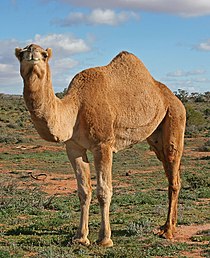
The dromedary camel (Camelus dromedarius) is a large even-toed ungulate native to northern Africa and western Asia. It is often referred to as the one-humped camel, Arabian camel, or simply as the "dromedary".
Portal:Africa/Featured picture/21

Leucospermum (Pincushion or Pincushion Protea) is a genus of about 50 species of flowering plants in the family Proteaceae, native to Zimbabwe and South Africa, where they occupy a variety of habitats, including scrub, forest, and mountain slopes.
Portal:Africa/Featured picture/22

Ancient Egypt was a civilization in northeastern Africa concentrated along the middle to lower reaches of the Nile River, reaching its greatest extent in the second millennium BC, during the New Kingdom. It stretched from the Nile Delta in the north as far south as Jebel Barkal at the Fourth Cataract of the Nile, in modern-day Sudan.
Portal:Africa/Featured picture/23

A pre-Mercator nautical chart of 1571, from Portuguese cartographer Fernão Vaz Dourado (c. 1520 – c.1580). It belongs to the so-called plane chart model, where observed latitudes and magnetic directions are plotted directly into the plane, with a constant scale, as if the Earth were plane. The Moors from Spain had maps of the known world, and had been traveling to and from Mecca, Arabia for many years. In 1492, Christopher Columbus had possession of the Maps of the Moors, which had been confiscated from Andalusia and were now in service to Portuguese and Spanish Explorers. The African Moors already knew at that time, well into the 1500's, that the world was round.
Portal:Africa/Featured picture/24
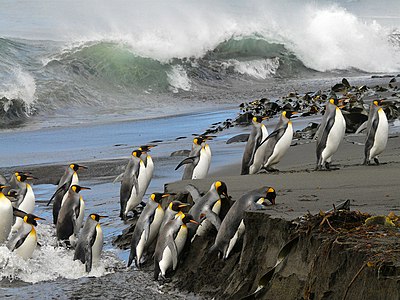
King penguins (Aptenodytes patagonicus) on shore of Île de la Possession or "Possession Island".
Portal:Africa/Featured picture/25
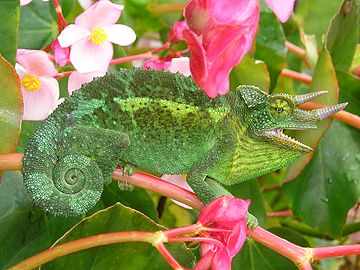
Chamaeleo jacksonii (common names Jackson's Chameleon or Three-horned Chameleon) is an African chameleon belonging to the chameleon family (Chamaeleonidae). It is native to the humid, cooler regions of Kenya and Tanzania.
Portal:Africa/Featured picture/26
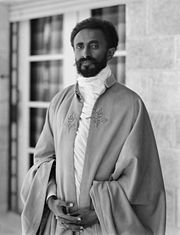
Haile Selassie I (July 23, 1892 – August 27, 1975), born Tafari Makonnen, was Ethiopia's regent from 1916 to 1930 and Emperor of Ethiopia from 1930 to 1974. The heir to a dynasty that traced its origins to the 13th century, and from there by tradition back to King Solomon and the Queen of Sheba, Haile Selassie is a defining figure in Ethiopian and African history.
Portal:Africa/Featured picture/27

Idi Amin (c. 1925 – 16 August 2003) was President of Uganda from 1971 to 1979. While President, Amin committed acts of violence against the people of his country; an estimated 300,000, possibly 500,000 civilians may have been killed under his regime. In this caricature by Edmund S. Valtman, Amin is depicted as a bloated, powerful figure in military dress covered with medals and insignia, holding a scepter, and crowned by a small head with heavy features.
Portal:Africa/Featured picture/28
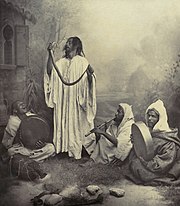
Snake charming is the practice of apparently hypnotising a snake by simply playing an instrument. A typical performance may also include handling the snakes or performing other seemingly dangerous acts. The practice is most common in India, though it is also practiced in the North African countries of Egypt, Morocco, and Tunisia. This photo depicts snake charmers in late 19th-century Morocco.
Portal:Africa/Featured picture/29

The Eritrean Railway, the only railway system in Eritrea, was constructed between 1887 and 1932 by the Kingdom of Italy for the Italian colony of Eritrea, and connected the port of Massawa with Bishia near the Sudan border. The railway is narrow gauge and is slowly being rebuilt after the devastation wreaked upon it during the war of independence. It still manages to operate, however, despite its newest equipment being nearly fifty years old, with most of it predating World War II. It is one of the few railway systems still in existence (excluding tourist railways) using equipment like the 1930s Italian-built 'Littorina' railcars behind 1930s-vintage Mallet steam locomotives.
Portal:Africa/Featured picture/30

Bareina is a Bedouin village and rural commune in the Trarza region of south-western Mauritania. As of 2000 it had a population of 14,987. This photo is a view of the village just minutes before rain started.
Portal:Africa/Featured picture/31
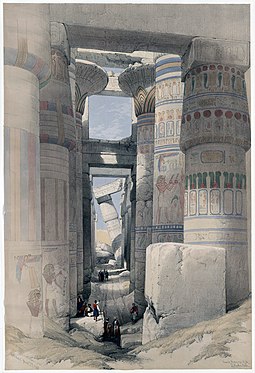
Karnak is a vast conglomeration of ruined temples, chapels, pylons and other buildings near Luxor, Egypt. This was ancient Egyptian Ipet-isut ("The Most Selected of Places"), the main place of worship of the Theban Triad with Amun as its head, in the monumental city of Thebes. This tinted lithograph depicts the hypostyle hall of the Precinct of Amun-Re, as it appeared in 1838.
Portal:Africa/Featured picture/32

Tadrart Acacus (Arabic: تدرارت أكاكوس) is a desert area in western Libya and is part of the Sahara. It is situated close to the Libyan city of Ghat. Tadrart means 'mountain' in the native language of the area (Tamahaq language). The Acacus has a large variation of landscapes, from differently coloured sanddunes to arches, gorges, rocks and mountains. Major landmarks are the arches of Afzejare and Tin Khlega. Although this area is one of the most arid of the Sahara, there is vegetation, such as the callotropis plant. The area is known for its rock-art and was inscribed as a UNESCO World Heritage Site in 1985 because of the importance of these paintings and carvings.
Portal:Africa/Featured picture/33

Mikumi National Park is a national park in Mikumi, near Morogoro, Tanzania. The park was established in 1964, currently covers an area of 3230 km² and is the fourth largest in the country. The landscape of Mikumi is often compared to that of the Serengeti. The road that crosses the park divides it into two areas with partially distinct environments. The area north-west is characterized by the alluvial plain of the river basin Mkata. The vegetation of this area consists of savannah dotted with acacia, baobab, tamarinds, and some rare palm. In this area, at the furthest from the road, there are spectacular rock formations of the mountains Rubeho and Uluguru. The southeast part of the park is less rich in wildlife, and not very accessible.
Portal:Africa/Featured picture/34

Moshi is a Tanzanian town with a population of 144,739 (2002 census) in Kilimanjaro Region. The town is situated on the lower slopes of Mt Kilimanjaro, a volcanic mountain that is the highest mountain in Africa. Moshi is home to the Chagga and Maasai tribes and lies on the A 23 Arusha-Himo east-west road connecting Arusha and Mombasa, Kenya. Just to the east of Moshi is the intersection with the B 1 north-south road eventually connecting with Tanga and Dar es Salaam.
Portal:Africa/Featured picture/35

Morogoro is a city with an urban population of 206,868 (2002 census) in the southern highlands of Tanzania, 190 km west of Dar es Salaam. It is the capital of the Morogoro Region. It is also known informally as "Mji kasoro bahari," which translates as 'city short of an ocean/port'.
Portal:Africa/Featured picture/36

Dar es Salaam is the largest city in Tanzania. It is also the country's richest city and a regionally important economic centre. Dar es Salaam is actually an administrative province within Tanzania, and consists of three local government areas or administrative districts: Kinondoni to the north, Ilala in the center of the region, and Temeke to the south. The Dar es Salaam Region had a population of 2,497,940 as of the official 2002 census. Though Dar es Salaam lost its official status as capital city to Dodoma in 1974, it remains the center of the permanent central government bureaucracy and continues to serve as the capital for the Dar es Salaam Region.
Portal:Africa/Featured picture/37

Tanzanians in Dar es Salaam protesting the 2008-2009 Gaza bombardment by Israel. International reaction to the conflict was also notable in the level of civilian demonstrations all around the world, which in many cases displayed sentiment significantly different from the official government line.
Portal:Africa/Featured picture/38

A Tanzanian boy transports fodder on his bicycle, to feed cattle. In agriculture, fodder or animal feed is any foodstuff that is used specifically to feed domesticated livestock, such as cattle, goats, sheep, horses, chickens and pigs. Most animal feed is from plants but some is of animal origin. "Fodder" refers particularly to food given to the animals (including plants cut and carried to them), rather than that which they forage for themselves (see forage). It includes hay, straw, silage, compressed and pelleted feeds, oils and mixed rations, and also sprouted grains and legumes.
Portal:Africa/Featured picture/39

The Great Sphinx of Giza is a statue of a reclining lion with a human head that stands on the Giza Plateau on the west bank of the Nile, near modern-day Cairo, in Egypt. It is the largest monolith statue in the world, standing 73.5 m (241 ft) long, 6 m (20 ft) wide, and 20 m (65 ft) high. It is the oldest known monumental sculpture, and is commonly believed to have been built by ancient Egyptians in the third millennium BC. After the Giza Necropolis was abandoned, the Sphinx became buried up to its shoulders in sand. The first documented attempt at an excavation dates to c. 1400 BC. In 1817 AD, the first modern archaeological dig, supervised by the Italian Captain Giovanni Battista Caviglia, uncovered the Sphinx’s chest completely. The entire Sphinx was finally excavated in 1925.
Portal:Africa/Featured picture/40
Dar es Salaam is the largest city in Tanzania. It is also the country's richest city and a regionally important economic centre. Dar es Salaam is actually an administrative province within Tanzania, and consists of three local government areas or administrative districts: Kinondoni to the north, Ilala in the center of the region, and Temeke to the south. The Dar es Salaam Region had a population of 2,497,940 as of the official 2002 census. Though Dar es Salaam lost its official status as capital city to Dodoma in 1974, it remains the center of the permanent central government bureaucracy and continues to serve as the capital for the Dar es Salaam Region.






